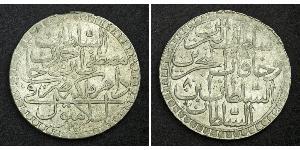(sold for $47.0)
1476, Electoral Paletinate (Pfalz), Frederick I. Silver Weisspfennig Coin. VF!
Mint Place: Heidelberg Mint Period: 1454-1476 Reference: Noss I 191/192. Rare! Denomination: Weisspfennig ("white penny") Condition: Minor environmental damage (light corrosion), light deposits, otherwise a nice VF! Diameter: 24mm Weight: 1.95gm Material: Silver
Obverse: Half-length figure of Saint Peter, holding cross-topped scepter and large key. Shield of Paletinate/Bavaria below, gothic structure around. Legend: FRID´ C´ P´ - DUX BA´ Reverse: Quartered shield of Bavaria/Paletinate within polylobe with three shields with arms of Maizn/Cologne and Trier. Legend: MONE´ - NOVA - hEIDEL
The County Palatine of the Rhine (German: Pfalzgrafschaft bei Rhein), later the Electorate of the Palatinate (German: Kurfürstentum von der Pfalz) or simply Electoral Palatinate[1] (German: Kurpfalz), was a territory in the Holy Roman Empire (specifically, a palatinate) administered by the Count Palatine of the Rhine. Its rulers served as prince-electors (Kurfürsten) from "time immemorial", were noted as such in a papal letter of 1261, and were confirmed as electors by the Golden Bull of 1356.
The fragmented territory stretched from the left bank of the Upper Rhine, from the Hunsrück mountain range in what is today the Palatinate region in the German federal state of Rhineland-Palatinate and the adjacent parts of the French regions of Alsace and Lorraine (bailiwick of Seltz from 1418 to 1766) to the opposite territory on the east bank of the Rhine in present-day Hesse and Baden-Württemberg up to the Odenwald range and the southern Kraichgau region, containing the capital cities of Heidelberg and Mannheim.
The Counts Palatine of the Rhine held the office of Imperial vicars in the territories under Frankish law (in Franconia, Swabia and the Rhineland) and ranked among the most significant secular Princes of the Holy Roman Empire. Their climax and decline is marked by the rule of Elector Palatine Frederick V, whose coronation as King of Bohemia in 1619 sparked the Thirty Years' War. After the 1648 Peace of Westphalia, the ravaged lands were further afflicted by the "Reunion" campaigns launched by King Louis XIV of France, culminating in the Nine Years' War (1688–97). Ruled in personal union with the Electorate of Bavaria from 1777, the Electoral Palatinate was finally disestablished with the German mediatization in 1803.
Frederick I, the Victorious (der Siegreiche) (1 August 1425, Heidelberg – 12 December 1476, Heidelberg) was a Count Palatine of the Rhine and Elector Palatine from the House of Wittelsbach in 1451–76.
He was a son of Louis III, Elector Palatine and his second wife Matilda of Savoy. His maternal grandparents were Amadeus, Prince of Achaea and his wife Catherina of Geneva.
He ruled the Electoral Palatinate after the death of his brother Louis IV as regent for his nephew Philip, Elector Palatine. He adopted his nephew in 1451 and refused to marry. From this "Arrogation," he claimed the right to be the legitimate elector. As this action was against imperial law, Emperor Frederick III refused to confirm Frederick's status. However, the emperor did not manage to displace Frederick who was an able strategist and allied with Louis IX, Duke of Bavaria.
Frederick was also successful against other opponents such as the emperor's party follower Albrecht III Achilles, Elector of Brandenburg and Diether von Isenburg, the archbishop of Mainz, and increased his territory. With the Battle of Seckenheim during the Bavarian War (1459–63) Frederick captured his antagonists Bishop George of Baden, Charles I, Margrave of Baden-Baden and Ulrich V, Count of Württemberg.
In 1471/1472, Frederick married his long-time mistress Clara Tott. She was a commoner and this was considered a morganatic marriage. They had two children:
- Friedrich von Wittelsbach (1461–1474).
- Louis I, Count of Löwenstein (29 September 1463 - 1524). Married first Elisabeth von Montfort and secondly Sophia Böcklin. Ancestor of the further rulers of Löwenstein. He was also an eleventh-generation ancestor of Adelaide of Löwenstein-Wertheim-Rosenberg, wife of Miguel I of Portugal.

|
Posted by:
anonymous 2018-07-09 |






















